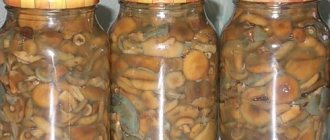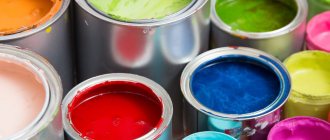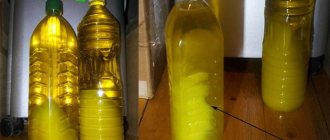Tara-Plastic for winemaking. YOUNG FIGHTER WINEMAKER COURSE.
Plastic containers for winemaking. SAY A WORD ABOUT HARMFUL PLASTICS! NO, NO, DON'T LET HER GO TO THE THRESHOLD!
The most popular and important equipment for winemaking is containers for fermentation and then for storing wine. If you can do without other equipment, then you can’t make good wine and do without the right suitable containers for storing it.
The best wines ferment in glass and stainless steel containers, clean and sterilized. The wines are then aged in oak barrels. But such barrels need to be soaked, steamed, fumigated, and new barrels must be treated and leached. All of this takes time and makes sense if you plan to make hundreds of liters of wine a year. Large glass carboys, tanks or stainless steel cylinders are a good choice for the beginning winemaker. These materials are easy to care for, durable and will not spoil the taste of the wine prepared in them. But plastic, including the so-called. food grade, experienced winemakers recommend NOT to use.
Below is an article by Crimean winemaker Sergei Nedokhlebov about the dangers of plastic containers in winemaking as a material for fermentation and storage of wine, and the inadmissibility of its use. And this is the author’s reasoned point of view.
A young winemaker, as a rule, lacks not only experience, but also equipment. Including containers. Having familiarized himself with the prices for stainless steel, oak, glass, the winemaker clutches his head, but then the helpful market pushes him towards convenient, cheap and affordable plastic products. Any shape, size, color, and often labeled “For food”. "Can?" - asks the gullible neophyte, and receives the answer: “Of course, silly, everyone takes it and no one has complained yet!” And now - the problem is solved. But at the same time, other problems begin that do not affect immediately, but very seriously.
I’ll be honest: when I was preparing this material, I really hoped that I would be able to put in a good word for plastic containers. It is really very convenient and very, very cheap. And I have quite a lot of it: two dozen large buckets, a dozen smaller ones, a dozen tubs of different sizes, several barrels, ladles, watering cans, lids, eggplants, bottles... Of course, there is glass for four tons and stainless, enameled and wooden tubs and tubs in general half a ton volume for fermentation. But at the stage of harvesting, storing grapes, fermenting, decanting, and transporting – plastic. And if there is a shortage of safe containers, for example, for petiots, even for fermentation - plastic. Of course, I already knew that plastic and alcohol are not very compatible and took precautions. I used the purchased plastic container for about a year only for process water, did not keep it in the heat or sun, reducing the period of stay of wine materials in it. But researching this issue made me reconsider my view on the permissibility of contact between plastics and alcohol. So, the conclusion is
THERE ARE NO PLASTICS THAT CAN HOLD ALCOHOL DRINKS!
Of course, the polymers themselves are neutral and harmless. But in the thickness of the plastic there is a large number of unpolymerized molecules. All of them are poisonous to humans. First, those that are on the surface are highlighted. Subsequently, those that are released during mechanical damage to polymer molecules or their destruction under the influence of air, light and temperature. Polymer molecules are insoluble in either water or alcohol. But ALL plasticizers and plastic stabilizers are soluble in alcohol. The intensity of their dissolution is directly proportional to the alcohol strength. But even in low-alcohol media, for example, beer, after a week of storage in PET bottles considered the least dangerous, at low storage temperatures, phthalates are detected. This was confirmed by a recent study by the Institute of Biochemical Physics of the Russian Academy of Sciences. Doctor of Chemical Sciences, head of laboratory
analytical methods for studying food products at the Institute of Nutrition of the Russian Academy of Medical Sciences, Konstantin Eller is categorical: “All alcohol-containing drinks work as organic solvents.” Of course, responsible manufacturers are working on the safety of containers and even from time to time announce that a new type of plastic is harmless. But this is before the first independent verification.
The issue of the safety of plastic containers is discussed quite often on the Internet. There are recommendations, for example, to use only containers with recycling code numbers 1 and 2 (this is the number inside the triangle of curved arrows). But this only applies to various types of polyethylene terephthalate (PET, PETE, PEHD, HDPE). Products under code 4 (LDPE, PEBD) are considered slightly more dangerous. But all of them, when in contact with alcohol, release formaldehyde, phthalates, and when destroyed by light, also methanol. Bottles, water flasks, and canisters for food liquids are made from these types of plastic. At room temperature, away from light and alcohol, they are harmless.
Larger products (barrels, canisters, tubs) are made from other plastics: 3 (PVC) polyvinyl chloride - releases vinyl chloride, bisphenol A. 5 (PP) polypropylene - releases formaldehyde, especially intensely when in contact with alcohol. 6(PS) polystyrene - releases styrene and formaldehyde. 7 (other types of plastics, their mixtures) distinguish different “bouquets” depending on the composition. (PC) polycarbonate, from which “office” water bottles are made, releases bisphenol A very actively when in contact with alcohol. A new American development for such Tritan bottles, declared safe, releases diethyl hexyphtholate.
The consequences of the accumulation of all these substances in the body are sad. Oncology, obesity, disorders of the central and peripheral nervous system, diseases of the excretory organs, allergies, endocrine disorders, infertility, etc. The harmful effects of these substances on the human body have been proven by numerous studies and tests. Of course, a person does not suddenly or immediately fall ill; different organisms have different degrees of resistance and resilience. But with such a wide range of influences, everyone will certainly have a weak point. We also need to take into account the very high prevalence of plastics in our environment. In addition to dishes, these are household items, toys, clothing, building materials, etc. That is, the background level of these substances entering our body is very high. Therefore, you should not increase this influx with your own drinks.
Wooden container for making wine at home
A wooden container is an ideal option for fermenting a wine drink, and any experienced winemaker knows this very well. A material such as wood has many advantages, which is why it is recommended to use it in the process of making homemade wine.
Wooden barrels and kegs (best if they are made of oak) are simply created for winemaking, and after considering all their advantages, you can see this for yourself.
- Wood perfectly maintains temperature , and this is one of the most important factors when making a homemade wine drink. Regardless of how the temperature “jumps” in the external environment, the temperature in the barrel will remain stable.
- In wooden barrels, wine matures faster , due to the fact that air penetrates through the pores of such a container in exactly the amount necessary for proper fermentation. In addition, what is important, the air, penetrating through the cracks of wooden containers, is purified and enriched with those beneficial substances that natural wood contains.
- Wooden barrels do not allow sunlight to pass through at all , so the wine they produce has a signature beautiful hue.
Another important nuance: all containers used must be sealed and free from various types of damage (the pores of wooden barrels are not taken into account).
Types of containers for wine fermentation + how to choose
The quality and taste of homemade alcohol is influenced not only by the characteristics of the raw materials, but also by the characteristics of the fermentation tank. In order not to spoil beautiful grapes and other fruits, you should carefully consider the choice of containers.
The container should be convenient, voluminous and, most importantly, safe. Over the centuries, vessels made of different materials have been used for winemaking needs: from the famous oak barrels and ceramic amphorae to stone (concrete) baths and leather bags. The sizes of the vessels also varied: from modest bottles of a couple of liters to giant containers of several hundred, or even thousands of kilograms.
Is it possible to ferment wine in plastic containers?
Oak barrels of various sizes are considered the ideal fermentation tank. Glass containers are also good for making wine drinks. You can infuse in plastic containers, but take into account the right choice of plastic.
Plastic fermentation bottles are an excellent option for preparing wine for home use, if the plastic is chosen wisely, taking into account the labeling. Then the liquid contained in the plastic container will not acquire foreign odors and tastes, and will not become harmful to the human body.
Choosing container material
Metal
It is absolutely unacceptable to use aluminum and enamel containers for fermentation and storage of wine. These materials oxidize and give drinks an unpleasant taste, smell and color, not to mention harmful to health.
Food-grade stainless steel can, in principle, be considered as a fermentation container, but only as a last resort. Not only is it not cheap, has considerable weight and is opaque, but when stored for a long time it can give the wine a metallic taste. Therefore, it is better to look for a more worthy option, unless, of course, you plan to use bronze, like the ancient Chinese.
Clay
At first glance, the material is ideal: natural and tested by winemakers. But there are nuances here too.
Clay containers break easily.
It is difficult to select a water seal.
Even the strongest and highest quality clay (glazed and fired) tends to absorb odors, so reusing such a vessel can ruin the taste of the drink.
Bacteria easily accumulate and multiply on the surface of the material, which is not healthy. Therefore, a clay jug can be considered as an experimental disposable vessel, but should not be used as a permanent container for fermentation.
Plastic
More recently, winemakers reacted extremely negatively to the proposal to use plastic containers for making alcohol. However, with the widespread dissemination and improvement of the material, the attitude towards it has changed. Today, plastic containers are very popular and are successfully used for wine fermentation.
The main thing is to remember that cheap PET bottles should be used for these purposes with caution. They are convenient, affordable and light, but over time they can lose their positive properties and begin to release harmful substances into the drink. After one use, such containers should be immediately thrown away and replaced with a new one.
The best qualities are possessed by special strong food-grade plastic, which is available for sale in a wide range, although it would be hard to call it environmentally friendly. The “disadvantage” of the material is its opacity, which makes it difficult to observe the process. Although, in fairness, it is worth noting that there are also options that are being viewed. Nevertheless, Shake It Up leans towards natural containers, so the next two materials are beyond competition.
Tree
There is no need to describe the advantages of oak barrels and casks: it is not for nothing that they have been used for many centuries to store wines and other drinks. The material is especially good for long, quiet fermentation. In it, the drink breathes, and is enriched with tannins, and acquires a noble taste, and is perfectly stored, and such containers look beautiful and elegant.
If it were not for one “but”: not any wood is suitable for winemaking needs, and not even any oak - within Russia you can only find suitable material in the Crimea and the Caucasus. And oak containers will cost accordingly, not to mention the need for special care.
Therefore, whatever one may say, the best material for home winemaking is the latter.
Glass
Affordable, durable, easy to use, transparent, neutral - these are the only advantages. And choosing a shutter for it is easy as pie.
As a “minus”, perhaps, it is worth mentioning fragility, but if you stock up on high-quality thick glass, then in terms of strength it will not be inferior to plastic. More significant disadvantages, when compared with wooden packaging, are: the ability to transmit light, susceptibility to temperature fluctuations and lack of ventilation.
But all problems can be solved: you should choose a dark glass bottle, store it in a secluded place with a relatively constant temperature, and periodically pour the wine to enrich it with oxygen. If desired, you can wrap the container with felt or straw to limit light access.
Advantages and disadvantages of glassware
A glass wine preparation vessel is perhaps one of the most used types of fermentation vessels, but is glass really that good for winemaking? Let's start our acquaintance with glass containers with the advantages of this type of glassware.
Advantages of glass containers for preparing wine
- The glass container is transparent, which means that you can always see how the fermentation process is going on, i.e., everything will happen “before your eyes.”
- Glass containers are usually small, so they are easy to transport.
Disadvantages of a glass fermentation container
- Glass containers do not allow air to pass through, so wine from it (more often than from other containers) must be poured more than once during the fermentation process so that it can be saturated with oxygen.
- Glass itself does not hold temperature well, but is easily subject to temperature changes. If the temperature in the external environment changes, this is necessarily reflected in the temperature of the wort. This factor has a bad effect on the quality of the wine, especially if the degree decreases, because then the fermentation process of the wort slows down.
- The transparency of glass is its advantage and disadvantage at the same time. After all, in addition to the fact that you can observe the fermentation of the drink, you also risk spoiling it due to the light transmission of the dishes. The light that penetrates the wine through the walls of the glass container spoils its color, or even makes it colorless.
- Glassware (whether containers or special cylinders) is difficult to care for, since it has a narrow neck, and moreover, it can easily be damaged or broken.
Despite the fact that glass containers have more disadvantages than advantages, nevertheless, its use should not be completely denied. With the right approach to fermentation, maturing wine in glass containers will give excellent results.
Deciding on the volume of the container
Fermentation containers come in different sizes: 5, 10, 20, 30 and more liters. You should focus on your capabilities and the amount of raw materials.
For beginning winemakers with limited space, 5-10 liter bottles will do.
For those who have larger plans, you can choose 10-20 liter containers.
A larger volume may be problematic in terms of transportation, but if this does not bother you, 30-liter containers will also be used.
When choosing containers, you should consider:
The container for rapid fermentation should be filled no more than 3 quarters, or better yet 2 thirds, so a reserve volume is required. A wide neck is more convenient for this stage, as it makes it easier to remove foam and mix.
At the “quiet” stage, the vessel is filled almost to the neck, so there is no need for extra space. Keep in mind that during the primary fermentation of the wort and removal of sediment, the amount of the final product will be reduced by at least a couple of liters.
The ideal ratio of containers for the two stages may look like this: 20-liters for the first and 10-12-liters for the second.
Containers for storing finished wine
At home, wine can be stored in small barrels, standard wine bottles, preferably made of dark glass.
You can store the drink in a jar (2, 3, 5 liters), if it is possible to seal it hermetically with a glass lid (it is not recommended to use metal lids). Jars are convenient if the wine needs improvement and needs to “survive” the winter until the next harvest. Amateur winemakers often bottle wine in plastic bottles, but such a container cannot be considered suitable for storing wine, especially long-term wine. Wine is preserved very well in ceramic vessels, but at present such vessels can be classified as rare.
The finished wine is poured into standard wine bottles, which can be used to make racks, taking into account the fact that they must be stored in a horizontal position.
Any winemaker sooner or later has a question: where to ferment so much wine so as not to drink it immediately after preparation? The potential of eggplants and three-liter jars is quickly exhausted; not everyone inherits glass bottles from their grandparents. How to choose a decent fermenter, suitable for wine, beer and mash, and, moreover, the most affordable one? Let's share our experience!
The quality of the vessel in which the future mash, beer and especially wine will ferment, directly affects the quality of the prepared drink. A variety of materials are used to make such containers - previously they were made from clay, wood, later from glass, now fermenters are made from plastic and even some metals. There are containers for fermenting wine with and without a water seal, the volumes vary from modest five-liter tanks to huge 50 and even 100-liter tanks, and often various additional bells and whistles and cunning devices are attached to fermenters.
p, blockquote 1,0,0,0,0 –>
p, blockquote 2,0,0,0,0 –>
p, blockquote 3,0,0,0,0 –>
How can you not get lost in this variety and buy exactly what you need? Let's try to put everything on neat shelves!
p, blockquote 4,0,1,0,0 –>
We sift out the unnecessary and leave the necessary
The number of various “bells and whistles” to the vessel may vary. Some of them are really useful, others serve the function of attracting attention and nothing more.
Handles for easy carrying are definitely a plus when it comes to large containers. Those who have had to move 20-30 liter tanks will agree. With the help of special holders it is easier to carefully move the container without disturbing the wort. For large metal containers, wheels are also useful.
Water seal. You can buy it separately, but if it has already been selected and comes complete with the vessel, why not? The same goes for a special cap or stopper. Very convenient: you don’t have to adjust, glue or file anything. Just make sure that the accessory is easy to remove and wash.
The volume scale is a useful thing, especially if we are talking about a plastic container. With its help, you can track changes in the amount of wort and observe the process through a special window.
A built-in thermometer is convenient, but not necessary. It definitely won’t be superfluous, but it can be easily replaced with a cheap device that is glued to the vessel.
What to stock up on and what to buy for home winemaking
Home winemaking differs from home brewing, for example, in that it does not require any special equipment. Everything necessary for turning fruit and berry juice into wine can be found in every household. If not, go to the nearest china store. As I wrote in my book about winemaking, “Wine, liqueurs, cider,” everything in our business should be extremely simple. We will proceed from this.
Let's start with dishes for wort (or, in other words, juice squeezed from fruits or berries). Its volume, of course, depends on the volume of the wort itself, although nothing prevents you from pouring the wort into several containers. It is important that the dishes provide periodic and convenient access to the wort - for regular stirring, for example.
It is equally important that the container is covered with a lid to prevent midges from getting into the wort. But the most important thing is the material from which the dishes are made. It must be absolutely neutral to acid. Therefore, it is either stainless steel or glass, or, in extreme cases, food-grade plastic, the use of which has no special restrictions. Of course, it could also be a tree. More precisely, an oak barrel. But only one that has not been used before, because preparing a used barrel is a separate and difficult story, which, if you have no experience, it is better not to go into. The dishes can also be enameled, but with absolutely intact enamel, without cracks or chips. Dishes made from any other materials - aluminum, galvanized, copper, etc., are not suitable for winemaking.
For intermediate manipulations - pouring the wort, filtering it, aerating the wine, etc., it is advisable to have two or three pans of different sizes on hand. The requirements for the material of the pan are the same.
A good help in the work are jars of different “calibers”, adapted for screw caps.
The largest ones - up to 5 liters - are convenient for storing wine that is already in the stage of quiet fermentation. After the first filtration has been carried out, as a result of which the amount of filtered wine, as a rule, decreases, intermediate vessels, so to speak, come in handy - 2 and 3 liter jars. They allow you to redistribute the drink so that the filtered wine occupies the entire space of the dish. The smaller the air gap between the lid and the surface of the wine, the less the risk that unwanted microorganisms will begin to develop in the wine itself.
Now for the little things, although it’s hard to do without what we’re going to talk about in home winemaking. Firstly, you will need to stock up on a certain number of thin plastic tubes or a thin hose - for making a water seal and for filtering wine. The optimal diameter of the tube or hose is 6-8 mm; you should not take anything thinner. For example, tubes from disposable medical droppers turned out to be absolutely useless.
Funnels of different diameters are also an almost irreplaceable thing. Ideally, it is better to use glass ones, but it seems to me that there are much fewer problems with plastic ones. The main thing is to wash them thoroughly every time. To wash all winemaking equipment, as already mentioned in the first part, never use household detergents - only baking soda. Therefore, you should always have some amount of baking soda on hand.
Finally, such a useful thing as a cooking thermometer. When pasteurizing wine (it is possible that it may be necessary), it is difficult to do without such a thermometer. It is also useful in other cases - for measuring the temperature of fermenting wort, for example. Or - to measure the temperature of wine when it is being prepared for storage.
Later, when it comes to storing wine, wine bottles of different sizes will come in handy. A large selection of glassware allows you to better control the wine itself, study its behavior and, if necessary, make adjustments.
It is equally important that the container is covered with a lid to prevent midges from getting into the wort. But the most important thing is the material from which the dishes are made. It must be absolutely neutral to acid. Therefore, it is either stainless steel or glass, or, in extreme cases, food-grade plastic, the use of which has no special restrictions. Of course, it could also be a tree. More precisely, an oak barrel. But only one that has not been used before, because preparing a used barrel is a separate and difficult story, which, if you have no experience, it is better not to go into. The dishes can also be enameled, but with absolutely intact enamel, without cracks or chips. Dishes made from any other materials - aluminum, galvanized, copper, etc., are not suitable for winemaking.
Features of wort preparation
The wort is mainly prepared from fresh fruits or berries
It doesn’t matter if a person bought them or grew them himself. Initially, the raw materials are turned into pulp (crushed, crushed) and the juice is extracted from this mixture
After this, it is necessary to determine the level of acidity and sugar content in it in order to add components for successful fermentation.
The key to getting good juice for wort is choosing fresh, ripe and high-quality fruits
It is important to remember that it is prohibited to wash berries and fruits. Their peel contains yeast fungi that provide fermentation
Therefore, it is better to collect them early in the morning, when they do not have time to collect the day's dust.
The fruits must be cleaned of seeds, leaves, stalks, twigs and various debris. All this negatively affects the taste of the finished product and adds bitterness to it. After preparation, juice is obtained from the raw materials. The missing substances are added to it:
- yeast;
- tannin (for the astringency of wine and preventing it from souring);
- lemon acid;
- sugar;
- wine yeast.
It is important to identify and add not all components, but only those that are missing. This is influenced by the variety of selected fruits or berries.










